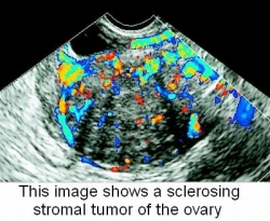Ovarian sex cord stromal tumors are abnormal growths that are created using tissues that are derived from the ovaries. Accounting for a relatively small percentage (5-10%) of ovarian cancers diagnosed. Diagnosing this form of cancer requires the completion of a biopsy. Because of the solid nature of this type of tumor, healthcare professionals tend to assume the tumor is malignant until proven otherwise by a biopsy.
These tumors differ clinically from the more common epithelial ovarian cancers. Around 70% of patients with these tumors are diagnosed when they are in stage 1, compared to about 75% of common epithelial cancers diagnosed when they are already at stage 3 or 4. As a consequence they are primarily treated with surgery and generally have a good prognosis.

One of the more apparent symptoms of this type of ovarian cancer is known as virilization. Essentially, this is a condition in which the female begins to develop traits that are more commonly associated with men. Among these symptoms is the development of facial hair that is far more pronounced than the slight dusting of facial hair that some women experience.
At the same time, the voice may become husky and somewhat hoarse sounding, effectively lowering it to a level that sounds almost masculine. There is also the possibility of vaginal bleeding, pain in the general area of the abdomen, and a change in the frequency and severity of the normal menstrual cycle. There are several different types of the sex cord stromal tumor.
A granulosa cell tumor is more likely to develop in women who are just past the age of menopause, often in their early fifties. This type of tumor accounts for 90% of sex cord tumors. Vaginal bleeding is one of the more common signs. While primarily considered a postmenopausal form of cancer, a granulosa cell tumor can also develop in young girls that are experiencing an early onset of puberty.
A Sertoli cell tumor produces an overabundance of Sertoli cells, which can create functional issues with the ovaries. Because Sertoli cells are produced at higher levels in men, women with this type of ovarian cancer are likely to find themselves developing noticeable facial hair or a gravelly voice.
In a similar manner, a thecoma can result in virilization. Because this tumor tends to produce higher levels of androgens, it can trigger growth of facial hair that is similar to that of men, as well as invoke other masculine traits.
The Leydig cell tumor triggers the production of Leydig cells, which are also more common for men than women. Like the Sertoli cell tumor and the thecoma, this form of sex cord stromal tumor causes the female to develop male traits like a lower voice and the sprouting of a beard.
When the tumor produces both Leydig and Sertoli cells, the growth is known as a Sertoli-Leydig cell tumor. As the tumor grows, it causes facial hair production to increase significantly, and can also create mild mood swings.
With gynandroblastoma, there is a combination of increased production of granulosa and Leydig or Sertoli cells in the ovaries. A woman suffering with this type of sex cord stromal tumor is likely to experience more pronounced changes in mood as well as a change in the voice and the appearance of more facial hair. There is also the possibility of vaginal bleeding to take place.
 The staging system used for sex cord stromal tumors is the same FIGO system used for epithelial ovarian tumors. With stage shown to be the most important predictor for survival in a number of studies.
The staging system used for sex cord stromal tumors is the same FIGO system used for epithelial ovarian tumors. With stage shown to be the most important predictor for survival in a number of studies.
Due to the rarity of these tumors, fertility-sparing surgery has not been widely studied, however one study showed that survival rates did not decrease when patients underwent this type of surgery. This is important given the fact that a lot of these tumors are diagnosed in young women who wish to preserve their fertility.